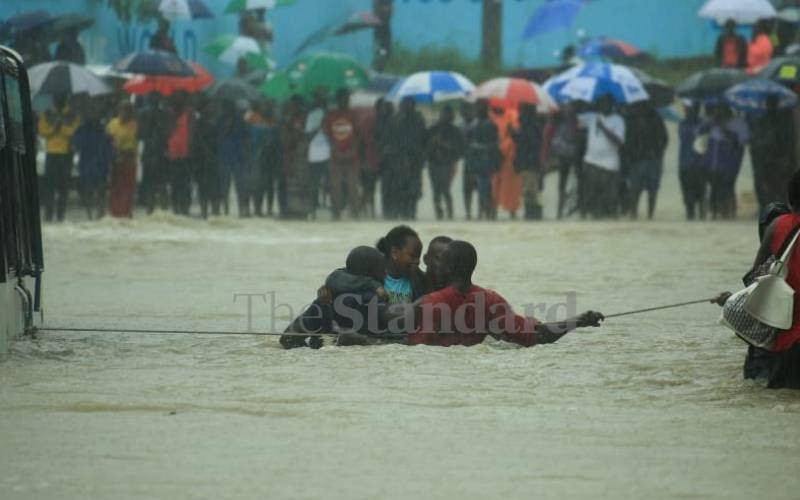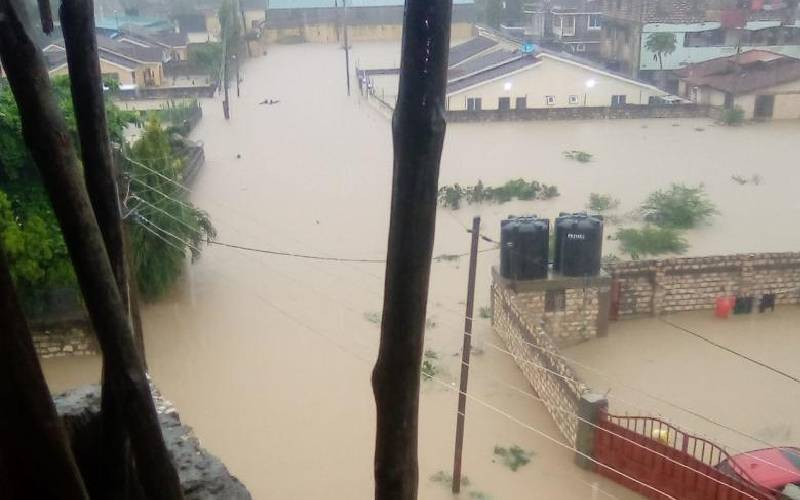The much-discussed El Niño rains have hit Kenya, causing floods that have killed over 50 people, displaced 80,000, and destroyed property worth millions.
But the question on Kenyans' mind is, where the billions of shillings allocated to mitigate the disaster? At issue is the Sh10 billion for disaster management that was to ease suffering of flood victims.
Despite allocating Sh4.4 billion to the National Disaster Management Authority (NDMA) in the 2023/24 supplementary budget, the government insists it has no money to address the floods.
Both national and county governments now say they lack funds to assist those impacted by the heavy rains that have cut off parts of the country.
- Stop blame game on El Nino and rescue Kenyans
-
Coast floods death toll rises to 20 as leaders hit out at Gachagua

On Tuesday, Deputy President Rigathi Gachagua claimed the national government had released Sh10 billion to the 47 counties for flood mitigation. In the same breath, he told off Mombasa Governor Abdulswamad Nassir for doing little to help flood-hit families in his county.
The deputy president, who was distributing relief food in Kisauni, demanded Nassir put development projects on hold and focus on distributing medical and food aid.
But Mr Nassir and Siaya Governor James Orengo quickly pointed out that no flood mitigation funds were disbursed to counties.
"I have heard that the deputy president was here in Mombasa. I have also been informed of his other speech. The truth is that the national government has not given a single cent to county governments. Even Nyeri County has not witnessed a penny. Siaya County is flooded too, and residents have been forced to vacate their homes. If Mombasa had benefited, I would have known. So, those are lies," said Mr Orengo.
The Council of Governors (CoG) also refuted Gachagua's claim that counties received El Niño preparedness and mitigation funds from the national government.
The council stated that no such funds were deployed to counties where floods have killed 52, displaced over 80,000 families, and damaged farmland.
"We note with concern public utterances that suggest that county governments have received funds from the national government to support the mitigation of the devastating impact of the El Niño rains," CoG chair Anne Waiguru said yesterday.
"We take the position that such utterances are against the spirit of cooperative and collaborative governments as envisioned under the provisions of Article 6(2) of the Constitution."
Ms Waiguru said 13 counties are owed Sh10.17 billion for September, 27 counties are owed Sh19.64 billion for October, while all counties are owed Sh32.76 billion for November.
"It is in such times we call upon the two levels of government to come together and intensify response strategies to mitigate against the complex risks arising from the heavy rains and flooding, in addition to the existing humanitarian challenges," she added.
In response, Mr Gachagua, who was speaking during the launch of the Development Partnership Forum in Karen, Nairobi, advised the counties to utilise their own funds to address the effects of El Niño.
And in a marked shift from his earlier statement on Tuesday, he said that the national government would not provide additional funds to the counties.
"We are therefore shocked to see governors complaining that they are yet to receive money for El Niño from the national government. Such money is not forthcoming. They are expected to use emergency money within their financial provision and to re-allocate money within their budget to intervene for the people that they govern," he said.

The council's admission has added to the confusion, especially after the Ethics and Anti-Corruption Commission (EACC) issued a prior warning about an 'impending scandal' in the mitigation measures for the El-Nino rains.
In a letter addressed to constitutional commissions, independent offices, and all county governments, the EACC emphasised the need for strict compliance with procurement laws.
"It has come to the attention of the commission that there is disregard of the law, in the initiation and implementation of some mitigation measures, which is likely to give room for financial impropriety and embezzlement of public funds," said EACC chief executive Twalib Mbarak.
A check by The Standard traced the confusion about the El Niño rains to a weather forecast earlier this year.
In August, weather experts warned of early signs of El Niño rains starting in September and lasting until January next year across the country.
But this prediction became a political issue when the President dismissed the forecasts, instead stating that the country would only experience heavy rains.
During a church service in Dagoretti last month, the President said that the Meteorological Department had scaled down the forecast from El Niño to short rains.
He added that this would enable farmers to increase production and safeguard the nation's food supply.
Following this, the Meteorological Department revised its alert, specifying that the upcoming rains would be substantial but not classified as El Niño.
This retraction, coupled with the fact that the department has not been issuing regular disaster updates -as they have to be approved by government- has compounded the woes of Kenyans who feel abandoned.
Amidst disputes among top government officials at both the national and county levels over funds and the authenticity of El Niño, leaders from the North-Eastern region have accused the government of neglect and discrimination in distributing El-Nino relief aid.
This criticism comes despite Parliament recently allocating Sh4.4 billion to the NDMA.
The distribution of emergency resources to mitigate the impact of El Nino seemed inequitable, especially considering that two-thirds of the region is submerged, with Wajir County experiencing the most severe effects.
Led by Eldas MP Adan Keynan, the MPs expressed concern that the anticipated assistance from the national government lacked clarity and thorough planning.
They made these remarks in Nairobi after flagging off 24 tonnes of food and drugs to six sub-counties in Wajir.
“We want the national government to come out properly and assist the residents of our counties. What is being coordinated and what we have been told is been coordinated, we are not seeing it at all,” said Mr Keynan.
Wajir Senator Mohamed Abass Sheikh took issue with the fact that the national government was yet to implement interventions to aid families in flood-hit areas.
“We want to know whether we are still a part of this country. The floods in Mombasa started earlier this week and the Deputy President has already outlined measures to assist the county government of Mombasa. What about Northern Kenya?” said Mr Abass.
Wajir West MP Yusuf Mohamed Farah accused the government of "slacking in its response to the problem as the magnitude and effort put in did not match".
"As Parliament, we have appropriated money to deal with these emergencies that ravaged our country, especially in northern Kenya, in the counties of Garissa, Wajir and Mandera. But we are seeing nothing on the ground as our people perish,” said Mr Mohamed.
The MP also urged the Kenya National Highways Authority to promptly repair the road section washed away by floods in Modogashe, saying the damage is impeding the flow of humanitarian assistance to Wajir and Mandera.
"Even if we airlifted all goods to Wajir County headquarters, you also need to airlift the same to areas that are far, and which have been submerged,” he said.
Tarbaj MP Hussein Bare noted that despite Parliament appropriating funds to tackle emergencies such El-Nino rains, the government was slow in expediting the release of funds and relief aid.
He accused the State of abdicating its role to the Kenya Red Cross Society and the Wajir County government.
Mr Bare said President Ruto should visit the region to appreciate the plight of residents.
Additional reporting by Noel Nabiswa By Josphat Thiong'o , The Standard




